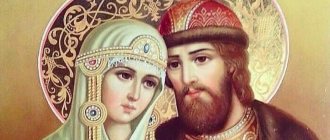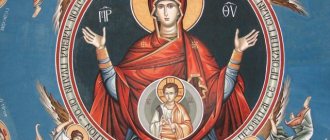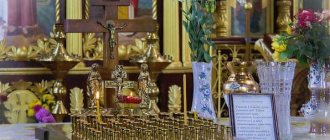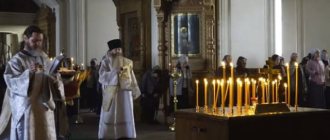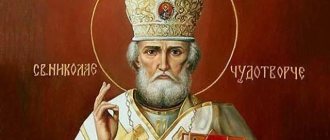The twelfth feast of Epiphany ( Epiphany) is one of the most mystical and mysterious in Christian Liturgics; it is also associated with many folk traditions and signs. However, the center of the Divine Service of these days is the consecration of water, symbolizing the Baptism of Christ. Christians come to churches on this day not only to offer prayer to God, but also to come into contact with the great shrine - the Epiphany water of great consecration.
Epiphany. Vladimir-Suzdal Historical, Artistic and Architectural Museum-Reserve, Vladimir. Second half of the 15th century
When is Epiphany water blessed?
Although the blessing of water on the feast of the Epiphany has been taking place for hundreds of years, in recent decades, apparently, under the influence of the dominance of godless authorities, some church truths, pious customs and paternal traditions associated with this holiday, unfortunately, have begun to be forgotten. Modern authors notice that they are being replaced by teachings and opinions borrowed from worldly life, from the practice of heterodox faiths.
Blessing of water on the day of Epiphany at the Russian Children's Center
Among such dubious borrowings is the doctrine of the “three waters,” which states that there are three types of holy water. The highest degree of sanctification has the water consecrated on the eve of Epiphany. This water can only be used within three hours after the rite of blessing of water. However, after three hours you can no longer store or drink it. The second degree of sanctification is possessed by water consecrated on the day of Epiphany itself. This water can be stored and consumed throughout the next year. The third degree of holiness is possessed by water consecrated during an ordinary water-blessing prayer service or consecrated on the first of August. It can also be consumed at any time.
Blessing of water prayer to Saint Spyridon of Trimifuntsky
Prayers addressed to this Saint will help you:
- Improve your financial condition
- Achieve success in business
- Attract monetary wealth
It is often recommended to order prayer services to this particular Saint if you are unable to resolve some issues related to these areas. The main thing is sincere prayer and your request will be heard.
It makes no difference to the Lord, the Mother of God or any other Saint you address your prayer and petition - the main thing in this matter is prayer from a pure heart, sincerity and purity of thoughts. After all, only with the help of firm faith can we convey our request to heaven. Only sincere faith can create miracles, which are sometimes so necessary for us!
God bless you!
In this video you will learn the text of the sequence of the water-blessing prayer:
How many times is water blessed on the Epiphany holidays, and how to store it throughout the year?
Big water - Epiphany - is blessed once, on January 5, and it is said about it that after three hours (long distance for the sake of distance, upon arrival - another hour) it is “dangerous” to store it - i.e. carefully, observe safely, like a shrine that Christians use, according to the reasoning of their spiritual father, instead of communion. After the consecration of water, every Christian has the right to sprinkle in his own yard for three hours, and “for the sake of distance,” i.e. if someone needs to go home tens, and sometimes hundreds of miles, then, upon arrival at the place, you can sprinkle your yard within an hour. If it is said in the “ Church Eye ” that “bless the water once, only in the evening,” then further in the same “Church Eye” it is said that the writer of this book does not know where this custom was borrowed from, and asks God-loving Christians who know this , “may they enlighten us too,” i.e. those who wrote this argument. Obviously, the Charter does not prohibit the blessing of water on January 6, but the one who wrote this remark did not know the reason why this should be done.
We find the reason for this custom in the explanation of St. Maximus the Greek , who speaks about it this way. Under the Greek Patriarch Photius, a custom still existed among former pagans who converted to Christianity. Every first day of the month they built a fire near their yards and jumped over it, because... Some converts to Christianity adhered to pagan superstitions and believed that this leap purifies a person and gives him health for a month. To destroy such a pagan custom, Patriarch Photius made an order to consecrate water every first day of the month and sprinkle the believers. This little by little weaned the newly converted Christians from their pagan customs.
The same patriarch decreed that in the month of January, instead of the first day, the consecration of water should be performed on the very feast of Epiphany, in addition to the consecration of the great water already prescribed according to the charter on the eve of Epiphany, i.e. 5 January. Thus, the custom was established to consecrate water on the first day of each month, with the exception of January, when consecration took place on the 6th, and February 2, when the consecration of water took place on the feast of the Presentation of the Lord. From here it is clear that on January 5, large water is blessed, and water blessed on January 6 has the same power as water blessed on August 1. And it is precisely the water that must be preserved that was consecrated on January 5; it is said about it that it sometimes replaces, according to the rector’s reasoning, holy communion when someone turns out to be unworthy to receive the Holy Mysteries.
Therefore, those who do not preserve this water only because they are afraid of spilling it or breaking the dishes are sinning. Unfortunately, this sinful and wrong view exists in many places among our Christians, and they, instead of reverently preserving the shrine, prefer to save themselves from worries about its preservation and drink this holy water on the same day. The same explanations about the Epiphany water - the “Great Hagiasma” - are available in ancient church statutes, the writings of the holy fathers and ancient Christian writers of St. Cyprian, Tertullian, St. Epiphany, St. Basil the Great and others. There is also a lot of historical evidence that in Rus' Christians kept water blessed precisely on the eve of Epiphany.
Moreover, in ancient times, during the reign of the Studite Rule in the Russian Church, there was no custom of the second blessing of water on the morning of Epiphany. Some researchers associate the appearance of the second consecration of water with the spread of the Jerusalem liturgical charter. However, this point of view does not seem entirely justified, since in the ancient editions of the Jerusalem Rule there is also no second consecration of water. The custom of consecrating water twice puzzled not only modern researchers, but also ancient Russian liturgists. In the manuscript “ Taktikon ” by Nikon the Montenegrin , rewritten by the holy monk Avksentiy (June 4, 1475), the following is said about double consecration:
Answer about enlightenment (blessing of water - author's note): The conciliar and holy Church did not decide to enlighten twice, but passionate human will. The cathedral church is once received in the evening, precisely to enlighten, as the Sobranitsa, who wrote to Sinoksare, write: the cathedral church is universally and universally, and in the monasteries again the Studite Typik, that is, the Imaginator, and the Jerusalem Typik, and others; and both the Apostle and the Gospel have one, the verb: from the evening, and no more [].
Unfortunately, the pious custom of the second great blessing of water on the feast of the Epiphany sometimes bewildered illiterate Christians. So, for example, the Monk Maxim the Greek pointed out that some ignorant people believed that the blessing of water was performed twice because Christ was baptized twice. However, this superstition was not widespread in Rus'.
Patriarch Nikon curses the second consecration of water
The real confusion began only after the church schism. Thus, Patriarch Nikon, biasedly studying the ancient studio regulations, completely prohibited the blessing of water on the very day of Epiphany:
In the current December 1640, the Great Sovereign Tsar and Grand Duke Alexei Mikhailovich of all Great, Small and White Russia, the autocrat, consulted with his father and the pilgrim with the Great Sovereign, His Holiness Nikon, Patriarch of Moscow and all Great, Small and White Russia, and with the entire consecrated cathedral , indicated: according to the ancient holy tradition of the Eastern Church, on the eve of the Epiphany of our God and Savior Jesus Christ, after the divine litorgy, without leaving your homes, go to the baptismal woman and there perform the blessing of water according to the order.
And on the very day of Epiphany, do not go to the baptist and do not dare to perform the Blessing of Water, and do not have one baptism according to the Apostle, and not two. For this reason, the holy eastern church commands the rite to be performed precisely on the eve of Epiphany. On the very Epiphany itself, you did not celebrate this holiday.
If anyone does not listen to this sovereign and sovereign patriarchal tradition of the ancient holy church, written in this memory, then such a message will fall under the great church execution. The Ecumenical Seventh Council imposes condemnation on those who disobey the holy rules, saying: If anyone, according to this testament, dares to think otherwise, let him be guilty of church execution, including curse and excommunication .”
How many times is Epiphany water blessed?
The decrees of Patriarch Nikon regarding the blessing of water were abolished by the Great Moscow Council of 1666–1667 as inconsistent with modern Greek practice. The Council decided to resume the double consecration of water, performing it on the eve of Epiphany and the next day. In contrast to Nikon’s curses, this council developed its own, even more terrible anathemas: “ If anyone does not listen to us or begins to contradict us... we are cursed and anathematized as a heretic and rebellious and cut off like a rotten oud . ”
However, the possibility of falling under the terrible curses of the cathedral and becoming “rotten ouds” did not frighten subsequent publishers of church books. In the new Typikon, mandatory for general church use, of 1682, the double blessing of water was again prohibited. After the death of Patriarch Joachim, New Believer theologians returned for the fourth time to the question of the consecration of the Epiphany water. The publishers of the Typikon of 1695 this time again “allowed” the second consecration of water. Unfortunately, the holy water leapfrog did not end there. In the synodal typikon of 1749, the article on the double consecration of water was crossed out. In the Typikon of 1791 it appeared again. In 1794, a new decree was issued not to publish such an article. There is no indication of the double consecration of water in the Typikon of 1814. This unfortunate article in the liturgical charter of the Synodal Church appears again only in 1838.
The water-sanctification confusion of the late 17th and early 19th centuries not only did not bring clarity, but also gave rise to various private opinions and beliefs. For example, some express the opinion that “Epiphany” and “Epiphany” waters have different powers. According to one version, Epiphany water is more blessed because the water consecrated on the eve of Epiphany is consecrated in special vessels in the temple, and the next day in an open reservoir. In the first case, the water is considered more “concentrated”, and in the second - “diluted”. Some parishioners even demand that when distributing water, they draw from the place where the cross was lowered. According to another version, Epiphany water is stronger because it is distributed in the church immediately after consecration, while Epiphany water is stored in the church for a whole year, diluted and “losing” its strength.
Blessing of water “in Jordan”. Romania
Today, the overwhelming majority of New Believer historians and liturgists declare that the water consecrated according to the charter on the eve of Epiphany, and the water consecrated the next day, are completely equal in power and are the same shrines, since the same rite is recited. True, academic authors express opinions much closer to ancient Russian ones. Thus, in the most authoritative multi-volume publication of the Soviet period, “The Handbook of a Clergyman,” the opinion expressed by Maxim the Greek and other ancient fathers is repeated:
There is an opinion that the actual epiphany was once the blessing of water on the occasion of the holiday, and on the holiday itself the blessing of water took place according to the rite of the small consecration, which in ancient times was performed at the beginning of each month (nowadays only the blessing of water on August 1 remains) [].
Thus, it is clear that the consecration of the Great Agiasma, the holy water of Epiphany, occurs only once a year . This sacred rite is similar to some other Christian sacraments and has a single duration of action. So, for example, a person can be baptized only once in his life, even though he has been immersed hundreds of times after that. Also, he can only receive Holy Communion once a day, even though he tries several times to receive the Holy Gifts. In fairness, we note that some modern Old Believer churches have returned to the early Christian tradition and consecrate water once - on the eve of Epiphany. This practice exists today in the Slavic-Georgian Ancient Orthodox Church.
Concept and meaning in Orthodoxy
The grace and blessing of God is transmitted through water to a person not only at baptism and after receiving the holy sacraments.
Everything that people need for life can be sanctified:
- Earth;
- air;
- water;
- objects;
- things;
- the buildings;
- products.
One of the most significant sacred rites in Christianity is the Blessing of Water (Great and Small). Worship over the water element cleanses it of evil forces and fills it with the grace of the Holy Spirit. When drinking consecrated water, the believer receives the blessing of the Heavenly King, which helps to cope with illnesses and life’s adversities.
The blessing of water takes place in churches according to the order established at the dawn of Christianity.
At water-blessing prayer services, the clergy offer prayers to the icons of the Mother of God and the saints:
- Kazan;
- Vladimirskaya;
- "Inexhaustible Chalice";
- Matrona of Moscow;
- Xenia of Petersburg;
- Nicholas the Wonderworker.
Before the prayer service, parishioners present at the service submit notes for the health of the people so that the priest will mention their names during the litany.
About communion (communion) with Epiphany water
Everyone knows that in the ancient Christian Church of the Water of Epiphany, the Great Agiasma, Christians who were not allowed to receive the Holy Gifts received communion as spiritual consolation. In any brochure dedicated to holy water, the reader will definitely come across a phrase from an ancient typicon: “Let him drink the agiasma.” That is, instead of receiving communion during penance, the repentant sinner was given the opportunity to consume Epiphany water. This secret action had a high spiritual, moral and ecclesiastical meaning. People who committed sins, were excommunicated from the communion of the Body and Blood of Christ and were under penance imposed by their spiritual father, nevertheless did not fall out of church communion. During months or years of excommunication, they received holy Epiphany water as spiritual consolation. At the same time, repentant sinners regularly confessed to their spiritual father, improved their lives and, realizing their inferior position, strived for full church communion in Christ - through the communion of the Holy Mysteries.
The Fathers of the Church, who established this saving ritual, understood that depriving a repentant sinner of any shrine would lead him to despair, despondency, and even falling away from the Church. On the need for communion with St. One of the great church teachers, St., spoke with Epiphany water. John Chrysostom. He owns one of the editions of the Rite of Communion with Holy Water of the Great Epiphany Consecration . The prayers of John Chrysostom have survived to this day. The Russian Church has them in appropriate sequences, placed in pre-schism and Old Believer publications. The communion of penitents with holy Epiphany water was widespread in the ancient Russian church. We can find information about this in ancient monastic manuscripts, liturgical charters, in additional parts of ancient Missals of the 12th–16th centuries and other written sources. Detailed information about the communion of St. Epiphany water is contained in the collection of St. Kirill Belozersky , the so-called “ Encyclopedia of the Russian Abbot ”. This document quite clearly and unambiguously tells about the canonical norms and church rules that existed in ancient Rus'. The chapter on communion says:
Having previously prophesied about any sins - that he would be excommunicated either for one year, or 2 years, or 3, or 4, or 5, or 6, or 7, or eight - sling him against the power of each... And on the Nativity of Christ, and on Epiphany, and on Maundy Thursday, and on Great Saturday, and on Easter - let him eat agiasma , which is holy water, and on Peter’s Day, and on the Dormition of the Most Holy Theotokos...” [].
Thus, Christians under penance could partake of St. Epiphany water not only from time to time, but also regularly - every twelfth holiday, like the others, honored by St. gifts. The presence of this information in the personal collection of Rev. Kirill Belozerskaya is of particular importance to us. It is known that the venerable abbot spiritually cared for not only monks, but also many prominent laymen of the then Rus'. Therefore, his evidence undoubtedly points to general church practice. The tradition of communion with Epiphany water was preserved in the monastery of St. Cyril until the church schism. In the monastery's cellar record, dated 1655, we find:
If anyone, on the advice of his spiritual father, is unworthy to partake of the body and blood of Christ our God, he will partake of the holy waters of Epiphany both on Holy Pascha, and on Peter’s Day, and on the Dormition of the Theotokos, and on the Nativity of Christ, and on the Epiphany [].
After the church schism of the 17th century, the majority of Old Orthodox Christians retained the custom of communion with the holy Epiphany water. Oddly enough, the fierce persecution brought against the Old Believers contributed to an even greater spread of the consumption of Epiphany water. Many churches and monasteries were destroyed and desecrated. Due to the lack of consecrated altars and antimensions, the Old Orthodox priests in some places were unable to serve the Holy Liturgy for many years. the Great Blessing of Water every year .
Blessing of water on the day of Epiphany on Rogozhsky
Pious people kept the Great Agiasma throughout their lives, and if it was impossible to accept the body and blood of Christ, they partook of water on great holidays, in cases of illness, and even before death. The use of Epiphany water was the subject of the actions of some Old Believer Councils. The acts of the Iryum Council of 1723 state:
On Holy Epiphany, the great water for eternity, if there is a priest, should be performed according to church rules. And without a priest, use the old reserve water to bless the new one, according to the Book of Matthew the Corrector, where it is allowed to dilute the myrrh with oil if there is a shortage [].
An important element of this conciliar decision is the permission to multiply the Epiphany water using the water of the old consecration. Academician N.N. Pokrovsky pointed out that the Old Believers-chapels subsequently had a detailed conciliar justification for this practice. He writes, in particular:
The Ekaterinburg Cathedral of 1887 and subsequent councils in their decrees contain a detailed description of this second order of consecration of the Epiphany water, which by that time had become the only one. At the same time, ancient liturgical texts appropriate to the occasion were listed, which did not at all provide for Eucharistic meaning. Water was also consecrated on the Feast of the Savior (1.08), this “small” water was used, unlike the Epiphany, only “for the consecration of defiled vessels,” etc. . [].
After the restoration of the three-tier hierarchy in the Old Orthodox Church, there were no special changes in the use of the Great Hagiasma. As before, it was given to reforming Christians as spiritual consolation. So, for example, Bishop Arseny of Ural wrote in a letter to priest Stefan Labzin:
A woman who secretly reforms with you, but prays in the house with the Nikonians, should not be allowed to partake of the holy mysteries of the body and blood of Christ, but if for some reason it is impossible for her to dissolve the marriage and does not like to lose Christian correction in confession, then let her come for confession, and to sanctify her you can give her Epiphany water. For this is a part of sanctification [].
In the New Belief, the use of the Great Water as spiritual consolation has long fallen into disuse. Not the least role in this was played by the resolution of the Synod of February 28, 1722, which allowed everyone to be admitted to communion, regardless of their sins.
For this reason, the holy church, which always has the sole authority to issue rules for the correction of its sons, according to the reasoning of the times and morals of man, forgives those who confess the ancient canon... He who repents and confesses his sins, whatever they may have been, is immediately admitted to the communion of the holy mysteries.
Nowadays, the custom of using the Great Agiasma as spiritual consolation continues to exist in Old Believer agreements. However, unfortunately, it is not practiced as often as in the pre-schism and pre-revolutionary Old Believer Church. Some confessors, excommunicating their children from communion or even temporarily not allowing them to take it, simultaneously excommunicate them from all other church sacred things. This custom cannot be considered completely pious for two reasons.
Firstly , it does not correspond to ancient Christian and Old Believer practices. Secondly , excommunication from all church shrines takes the flock outside the church fence. Left for many years without sacred communion with the church, without feeling the action of the grace of Christ, a Christian is subjected to severe trials and severe temptations that can lead to a break with the church. On the other hand, regular confession and communion with the water of Epiphany would undoubtedly become the most important elements of truly Christian repentance, the hope of forgiveness, sanctification, through the spiritual rebirth of man. Communion with the water of Epiphany could also help many newly arrived Christians, baptized in childhood, but who have not had contact with the church for many years, newly baptized, affiliated from heretical churches. Everyone knows that many of them do not have spiritual and ascetic experience, do not know the necessary prayers, and cannot maintain proper fasting and fasting. Temporarily preventing such people from receiving Holy Communion. secrets, confessors can nevertheless keep such Christians in church communion by regularly confessing and communing with the water of Epiphany.
Library of the Russian Faith Rite of Communion with Great Water →
Read online
Water Blessing
ORDER OF GREAT AND SMALL WATER CONSECTION. HISTORY OF THEIR EDUCATION
The Holy Church, with the word of God, prayer and sacred rites, sanctifies not only man himself, but also everything that man uses on earth: water, air and the earth itself, various objects and things necessary for our existence and well-being; she sanctifies and blesses them with a heavenly blessing - to communicate grace and blessing to man through them.
One of the most majestic and touching sacred rites over the elements is the consecration of water - an element so necessary for maintaining our life and for consecrating various objects. The Church sanctifies water in order to restore it to its original purity, to bring down upon it the grace of the Holy Spirit and heavenly blessing, to the sanctification of the souls and bodies of all who use it, to drive away the slander of all visible and invisible enemies and to all benefit for believers.
Two gospel events mainly sanctified the water: the baptism of the Lord in the streams of the Jordan and the stirring of the water by the Angel in the Pool of Siloam. In commemoration of these events, the Orthodox Church accordingly established two blessings of water: the great and the small blessing of water.
| Photo from the site Sedmitsa.Ru |
The Great Blessing of Water
is performed exclusively on Vespers and on the very day of the Feast of Epiphany. The Blessing of Water is called great because of the special solemnity of the rite and the remembrance of the Baptism of the Lord.
The Great Blessing of Water is performed at the end of the service on the eve of the holiday and on the very day of the holiday and mainly consists of: singing the stichera “The Voice of the Lord on the Waters,” reading three proverbs, the prokeme, the Apostle and the Gospel, a peaceful litany and a consecrating prayer with petitions for the consecration of water. And, finally, the very consecration of the water with the threefold immersion of the holy cross and the threefold singing of the troparion of Theophany: “I am baptized in the Jordan, O Lord.”
Small water blessing
is supposed to be done at the beginning of each month. On this basis, it takes place on August 1st and is therefore sometimes called the “August Blessing of Water.” Then the small blessing of water is performed at the end of Pentecost in remembrance of what Jesus Christ taught the people about living water flowing into eternal life (John 4:10). It is also performed before the liturgy on church holidays, on which the church is renewed with prayer and the sprinkling of holy water. Finally, it can be performed at the request of each believer at any time (at home or in church) in conjunction with prayer singing.
The small consecration of water, just like the great consecration of water, dates back to ancient times, to the first times of the Church.
In the Apostolic Decrees, the establishment of the sanctification of water is attributed to the Evangelist Matthew. According to the testimony of Baronius (for the year 132), the ancient custom of performing a minor consecration of water, which existed since the times of the apostles, was approved as a church rite by Alexander, Bishop of Rome, who suffered under the Emperor Hadrian (117-138). Balsamon, Patriarch of Antioch (12th century), in his interpretation of rule 65 of the Trullo Council, mentions the small blessing of water as an ancient custom and explains that the fathers of this Council decided to perform the small blessing of water at the beginning of each month in counteracting pagan superstitious customs in the new moon, which had been held for a long time among Christians.
The final formation of the rite of minor consecration of waters is attributed to the Patriarch of Constantinople Photius, who lived in the 9th century.
THE RITE OF THE SMALL CONSECTION OF WATER
The rite of the small consecration of water is entirely aimed at giving the believers grace in consecrated water, delivering them from sorrows and ailments of body and soul, disasters external and internal, temporary and eternal.
The Lesser Blessing of Water is similar in composition to Matins combined with lithium.
After the initial exclamation of the priest and the usual initial prayers, the 142nd Psalm is read, with the words of which the languid spirit and despondent heart of a Christian lift up prayer to the Lord in the hope of gracious deliverance from internal evils and sorrowful external circumstances.
After the psalm they sing “God is the Lord” and troparia to the Most Holy Theotokos as our first Intercessor in the Lord and the undoubted hope of all the desperate and perishing.
Then the 50th Psalm is read and instead of the canon, troparia to the Most Holy Theotokos are sung: “Rejoice, having received an angel...”.
These troparia (34 in number) contain a touching prayer to deliver us “from all need and sorrow.” In addition to prayers to the Mother of God, prayers are sent to the Archangels and Angels, John the Baptist, the apostles, martyrs and unmercenaries.
The corresponding choruses are sung for the troparions: “Most Holy Theotokos, save us,” “Holy Archangels and Angels, pray to God for us,” etc.
If the blessing of water is performed during a prayer service, then the rite of blessing of water begins (after reading the Gospel) with the singing of these troparions: “Rejoice” (the beginning of the rite of blessing of water is omitted).
After the singing of this first group of troparions, the deacon exclaims: “Let us pray to the Lord.”
Choir
: "Lord have mercy".
Priest
: “For You are Holy, our God...”
And after this the troparia are sung: “Now the time has come to sanctify everyone.” The troparia concludes with the singing of the Trisagion. During the singing of these troparions, small incense is performed at the temple or home.
After singing the troparions, the prokeimenon is pronounced, the Apostle (Heb. 2:11-18) and the Gospel (John 5:1-4) are read. The apostolic reading proclaims that the Lord, who sanctifies everyone, was himself tempted, and can help those who are tempted. The Gospel reading tells about the Jerusalem Sheep Font, in which the sick were miraculously healed when the water in it was stirred by an Angel.
After the Gospel, a peaceful litany is pronounced, in which petitions are sent for the sanctification of the water, so that it will be healing for our souls and bodies, and so that the Lord will deliver those who drink this water and those who are sprinkled with it from all sorrow, anger and need.
After the litany, the priest reads a prayer for the consecration of the water. This prayer differs from the prayer read at the great blessing of water. In the prayer of the small consecration of water, the Church, calling on the Mother of God, the Angels and the saints in intercession, begs the Lord to heal our mental and physical ailments, to grant health and salvation to His Holiness the Patriarch, the ruling bishop and all Orthodox Christians. At the same time, the water is blessed by the hand of the celebrant. Then the priest blesses the water three times with an honorable cross, immersing it in the water, and at the same time the troparion is sung three times: “Save, O Lord, Thy people...”.
After this, the priest sprinkles the temple (or house) and people, and at this time the choir sings the troparia: “Source of healings...”.
The blessing of water ends with a litia: an abbreviated, intense litany is said and then the prayer laid down at the all-night vigil at the litia “Master of Much Mercifulness...” is read, after which there is a dismissal, a cross is given for kissing with sprinkling of holy water.
The small blessing of water, in its structure and content, as we see, differs from the great blessing of water. The latter does not have an initial exclamation and the usual beginning with the reading of psalms and the singing of “God is the Lord” and troparions replacing the canon. There is only a similarity with the second part of the rite of the minor consecration of water, starting with the stichera: “Now the time has come to sanctify everyone.”
But even in this second part, the stichera and troparia for the consecration of water are different. So, for example, at a small consecration the troparion “Save, Lord...”, at a great consecration - “In the Jordan...”.
Finally, the rite of the Great Blessing of Water does not have a lithium at the end.
CONSUMPTION OF sanctified water
The water consecrated on the eve of the holiday and on the very feast of Epiphany is called the great agiasma, that is, the great shrine, because through the influx of the Spirit of God it received within itself great, Divine and miraculous power. Therefore, this water has important and extensive uses among Christians. The houses of believers are sprinkled with it on the evening of eternity and the feast of the Epiphany; believers can use it at any time with great reverence, eat it before eating, carefully store it throughout the year, sprinkle it and signify it for the health of soul and body. It is used by the Church during the consecration of the World, during the consecration of the antimensions, and during the consecration of the artos on the day of Easter. The Church determined that this same Epiphany water, together with the antidoron (i.e., with the remainder of the prosphora, from which part was removed for the Holy Lamb), should be given instead of communion of the Holy Mysteries of the Body and Blood of Christ to those who are excommunicated from communion of the Holy Mysteries or have not prepared themselves to receive their. Finally, the Church uses it when consecrating various substances that have been defiled in some way.
Water blessed according to the rite of the small consecration of water is called small agiasma, in contrast to the great agiasma - the water of the Holy Epiphanies, but its use is even more extensive than the latter. It is used by the Church when performing various kinds of rites and consecrating prayers, such as: during the consecration of temples, dwellings and everything that serves to support our bodily life, i.e. food and drink. The Church uses it when performing prayers that bless our good intentions, namely: when consecrating a new house, when setting off on a journey, before beginning good deeds. In all these cases, a small blessing of water and sprinkling of St. is performed. water for encouragement and grace-filled strengthening of believers for the labors and deeds set before them. Finally, the minor consecration of water is performed in difficult times of public and private disasters, because the Church, in the sanctified element, wants to give us grace that delivers us from troubles, illnesses and sorrows. The minor consecration of water is performed on church holidays before the liturgy, as a sign of the renewal of the unfading grace imparted to the church during its consecration.
Holy Yuryev Martyrs
In the center of the icon is the holy martyr Isidore . The Yuryev martyrs are pre-schism saints especially revered by the Old Believers of Estonia.
In 1472, in the city of Yuryev (now Tartu, Estonia), on the feast of Epiphany, by order of the Livonian bishop, during the great consecration of water on the Omovzha River, the rector of the Orthodox Church in the name of St. Nicholas, Fr. Isidore was captured and imprisoned. All the parishioners of his church, including women and children, were arrested along with him, 72 people in total. All of them were drowned in the consecrated Jordan.
How to sprinkle your home with holy water
Holy water, consecrated on the feast of Epiphany in remembrance of the Baptism of the Lord, has grace-filled gifts, “the blessing of the Jordan, the source of incorruptibility.” The Lord gives holy water “the gift of sanctification, the solution to sin and the transformation of illness, it is destructive to demons and impregnable to resisting forces, it is filled with angelic strength.” All who partake of it with faith receive blessing, cleansing, sanctification of soul and body, health and healing of passions.” Every Christian must drink the Great Agiasma, regardless of his sins (including, for example, smokers who ate on this day) within 3 hours after consecration (or, as an exception and beyond the distance, within one hour after arriving home ). Next, you need to consecrate all the objects in your house, barn and other places. Even “scarce places” are sprinkled with this water, i.e. toilets, barnyards, etc.
After the blessing of water, every Christian, upon arriving home, must stand before the holy icons and pray:
God, be merciful to me, a sinner (bow). Create me, Lord, and have mercy on me (bow). Without number of sins, Lord, have mercy and forgive me, a sinner (bow).
For the prayers of the saints, our fathers, Lord Jesus Christ, Son of God, have mercy on us. Amen (always bow from the waist).
Holy God, Holy and Mighty, Holy and Immortal, have mercy on us (three times, with bows). Glory to the Father and the Son and the Holy Spirit, now and ever and unto ages of ages, amen. Most Holy Trinity, have mercy on us. Lord, cleanse our sins; Master, forgive our iniquities; Saints, visit and heal our infirmities; for your name's sake. Lord have mercy (three times). Glory to the Father and the Son and the Holy Spirit, now and ever and unto ages of ages, amen.
Our Father, Who art in heaven. Hallowed be Thy name. Thy kingdom come. Thy will be done as it is in heaven and on earth. Give us our daily bread this day. And forgive us our debts, just as we forgive our debtors. And do not lead us into temptation. But deliver us from the evil one.
Lord Jesus Christ, Son of God, have mercy on us. Amen. (bow).
Then they sprinkle the entire house while singing the troparion:
In the Jewish world, we are baptizing our children, our spiritual worship, our parents’ voice of your testimony, our beloved’s witness, and our 3rd vision of the dove, and your words are affirmed. kvleisz xrte b9e, i3 mjr enlightenment, glory to you.
How to take and store Epiphany water
Holy water of minor consecration, which is consecrated on the day of Epiphany, January 6/19, is consumed throughout the year with prayer on an empty stomach or after eating prosphora, in small quantities, as well as for the consecration of dishes and other items. Although it is advisable - out of reverence for the shrine - to take Epiphany water on an empty stomach, but for a special need for God's help - during illnesses or attacks by evil forces (the demonic influence on our thoughts and feelings) - you can and should drink it, without hesitation, at any time.
Holy water is a church shrine, which has been touched by the grace of God and which requires a reverent attitude towards itself. It should be stored in a separate place, preferably next to the home iconostasis. It is not advisable to store holy water for a long time in a plastic container. In any case, old labels from soda, alcohol, or the like are not allowed on bottles. It is pious to stick a special note stating that holy water is stored in the vessel.
If necessary, holy water can always be “diluted” with fresh water, while singing the troparion “They are baptized in the Jordan, O Lord...”. At the same time, you should remember that you need to pour the blessed water into the plain water in a cross shape, and not vice versa.
Author: Gleb Chistyakov
Literature:
[1] Sofia collection 1432, f. 334-334 vol. Quoted from the Kelarsky everyday life book of Matthew Nikiforov, elder of the Kirillo-Belozersky monastery. 1655/1656. - M.: Indrik, 2002, p. thirty; [2] 1656 January 1. - Memory of Jonah, Metropolitan of Rostov and Yaroslavl, in the Kirillo-Belozersky Monastery. Quote according to the Kelarsky Obikhodnik, Matthew Nikiforov, elder of the Kirillo-Belozersky Monastery. 1655/1656. - M.: Indrik, 2002, p. 174; [3] Handbook for a clergyman. T. 1. Publishing department of the Moscow Patriarchate. 1992. p. 484; [4] Encyclopedia of the Russian abbot of the 14th-15th centuries. Collection of lecturers Kirill Belozersky. - St. Petersburg, Oleg Abyshko publishing house, 2003. P. 85; [5] Kelarsky everyday life book of Matthew Nikiforov, elder of the Kirillo-Belozersky monastery. - M.: Indrik, 2002. p. 102; [6] Spiritual literature of the Old Believers of Eastern Russia in the 18th-19th centuries. History of Siberia. Primary sources. Novosibirsk Siberian chronograph. 1999. P. 333; [7] Ir., Art. 5; Ek.1887, Art. 10, 11; Biy., Art. 1; B.-Bats., Art. 3; Ave., Art. 1; Min.1975, Art. 4; [8] Bishop Arseny of Ural. Justification of the Old Believer Holy Church of Christ. Letters. Moscow, - Kitezh Publishing House, 1999. P. 260.
Rules for using blessed water
After the ritual of consecration, water becomes a shrine upon which the Spirit of God descended. After the Great Blessing of Water, water is used to strengthen health and cleanse the soul. They keep holy water near the icon. You are supposed to drink a few sips on an empty stomach. For sick people and children, blessed water is added to their drinks and first courses. Before acceptance, read the Lord's Prayer silently to yourself.
The clergy give Epiphany water instead of communion to those excommunicated from the Holy Sacraments. It is sprinkled to consecrate desecrated objects.
Small agiasma (water according to the rite of small water blessing) is used for the consecration of homes, churches, food, people (before a long journey, during illness), during natural disasters, and the baptism of children.

